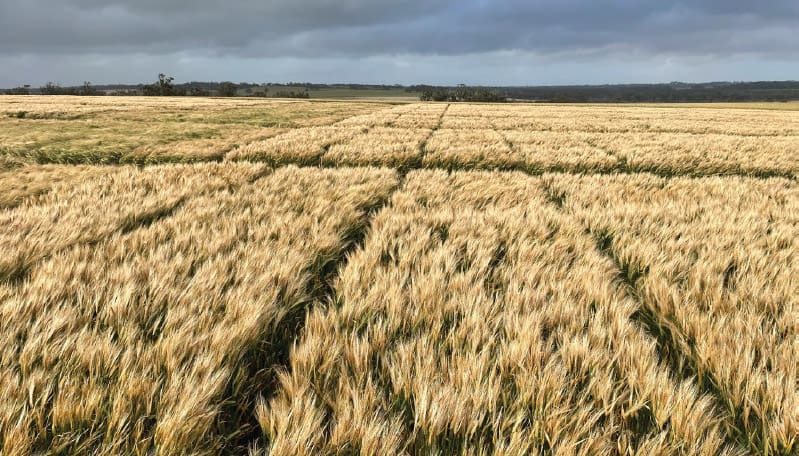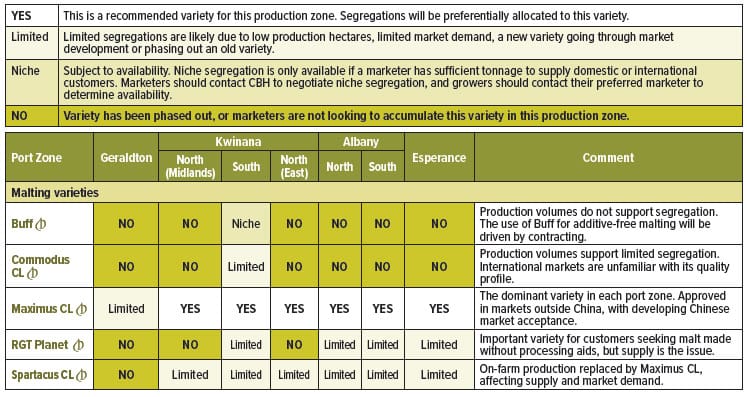
Western Australia is one of the world’s most significant producers and exporters of malting barley. Photo: GIWA
THE Grain Industry Association of Western Australia has released its malting barley variety receival recommendations for the 2025-26, with Maximus CL nominated as the preferred variety in each of WA’s port zones.
It accounts for two in every three hectares sown to barley in WA, and shows a move away from the French variety, RGT Planet which, along with Maximus CL, was a recommended variety for the 2024-25 season in two of the Kwinana zone’s three segments, and the entire Albany port zone.
Spartacus CL, which was a preferred variety for the current season in all zones bar Geraldton, has also been dropped.
Through the GIWA Barley Council, the recommendations are developed in consultation with the WA barley supply chain and aim to guide growers and consultants when planning the 2025 barley-cropping program.
GIWA Barley Council chair and InterGrain barley breeder David Moody said WA growers have 31 varieties to chose from, but a problem exists with the limited number of accredited malting varieties produced in sufficient volume to warrant segregation and export marketing.
“While Maximus CL is the dominant barley variety…the plan highlights how the low supply of RGT Planet may result in the exclusion of WA malt barley in several premium markets in Asia until there is sufficient production of other varieties which can routinely be malted without processing aids,” Mr Moody said.
“There are some options available to growers to mitigate the loss of RGT Planet, such as Buff, but production volumes and the environment in which it is grown do not support significant segregation opportunities in WA.
“With market pull and sufficient production, niche segregations could be offered for Buff, and this is something the WA supply chain needs to consider.”
Mr Moody said further malting barley options were likely to become available in 2025 after decisions are made on an extensive list of varieties in their second and final year of the accreditation process.

Table 1: WA malting barley variety segregation recommendations by port zone for the 2025-26 harvest. Source: GIWA
International market signals highlight preference for Australian malting barley’s generally low protein status, and the WA Malt Barley Variety Receival Recommendations plan suggests growers aim to deliver grain of 10.3-10.8 percent protein for domestic sales and 10.5-11pc for export.
This is despite the the receival window on protein being 9.5-12.8pc.
Other optimal specs include a minimum of 80pc retention on a 2.5mm sieve, testweight above 64kg per hectolitre, ryegrass ergot less than 3cm in length, no whole snails, and no use of glyphosate as a desiccant ahead of harvest.
New varieties in pipeline
Seven varieties in Stage Two of the Grains Australia Malt Accreditation Program, namely AGTB0318, Beast, Cyclops, Laperouse, Neo CL, Titan AX, and Yeti, are not included in the WA Malt Barley Variety Receival Recommendations for 2025-26.
Growers should expect a decision on the malt accreditation of those varieties during February or March 2025.
“Each year, the GIWA Barley Council works with the WA barley value chain to provide guidance to industry on the management of malt barley segregations in the bulk-handling system.”
“I strongly encourage growers and their consultants to take note of the recommendations within the plan when considering their 2025 barley cropping program.”
Praise for AEGIC
While China has re-emerged as the largest buyer of premium malting barley, FAQ malt multi-variety barley and feed barley from Australia, the industry has benefited from the extensive in-market awareness that has been fostered by the Australian Export Grains Innovation Centre.
“Over the last four years, AEGIC has been raising international awareness of the quality of Australian barley in Mexico, Peru, Ecuador, Africa, and Southeast Asia, as well as potential new markets in Brazil and Columbia.”
“This promotion supports the development of these new markets, and new customers, for WA barley and further solidifies Australia’s position as supplier of 30-40pc of the global malt barley trade.
“Market demand from China, Southeast Asia and Japan for premium malt barley remains positive, especially for varieties that can be malted without processing aids; however, we have seen the trade of feed barley to Saudi Arabia decline rapidly over recent years.
“Mexico, Peru, and Ecuador have become valued customers of malt barley grain as they only buy premium malt barley and without those markets, the spread between malt and feed barley would be tighter.”
Source: GIWA